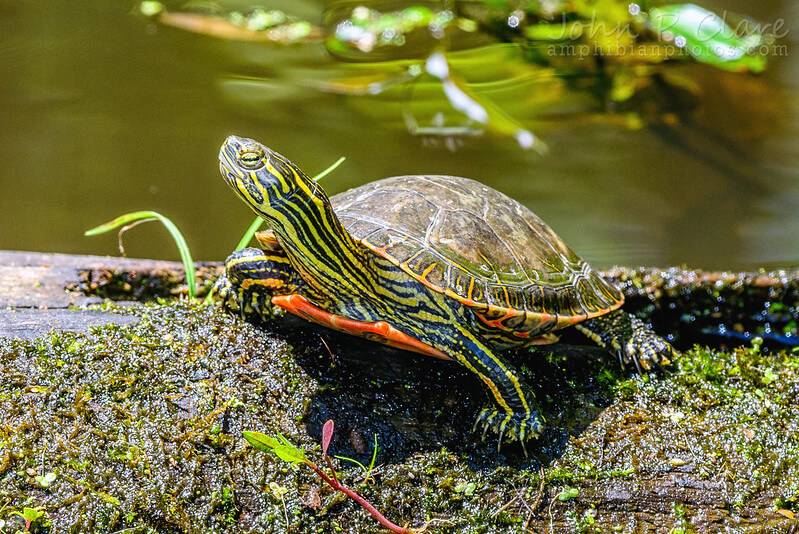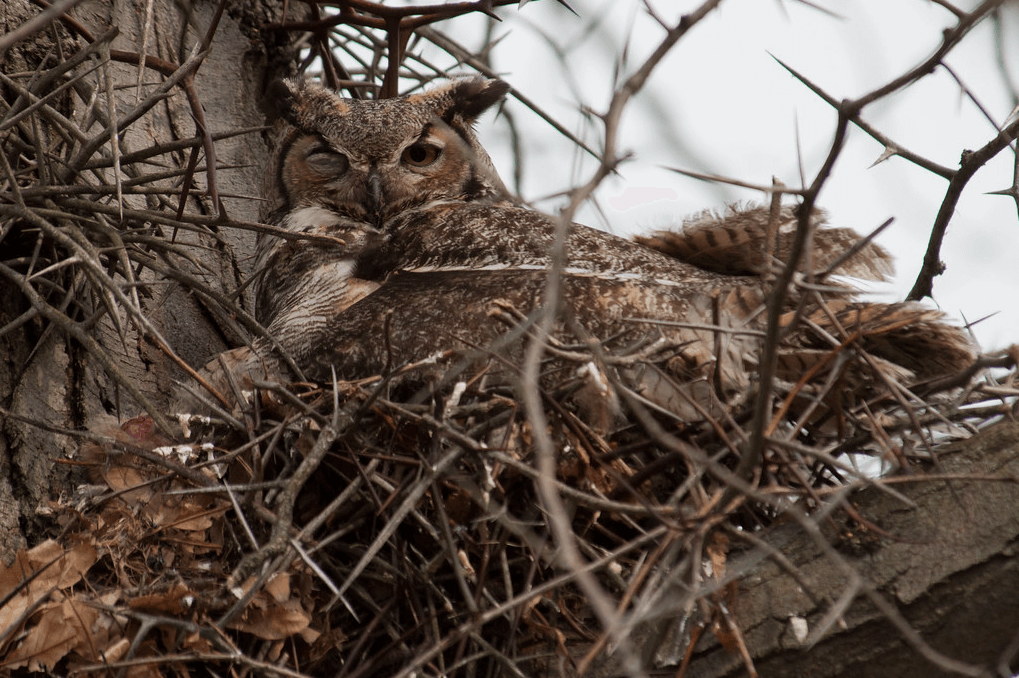Painted Turtles, Lovers of Water and Sun
By Charles Finn
Broadcast 9.2005, 8.2012, 8.2017

A western painted turtle suns itself on a log. Photo by John P. Clare, CC 2.0.
Listen:
They are the size of dinner plates, poker chips, catcher’s mitts stacked up in the sun. You see them on hot summer evenings crossing the road, or bobbing in a pond just under the water’s surface, the big toes of their heads pushed into the sky. They are toy tanks, the original mobile homes, frowning Buddhas on the boomed ends of logs.
This afternoon half a dozen adult painted turtles sun themselves on a log at the Lee Metcalf Wildlife Refuge in Stevensville, their markings striking in the slanting sun, crazy yellow lines that run across their faces, down their outstretched necks and over their arms. They face away from me, legs drawn up out of the water and their tails tucked in behind them. They balance like saucers, green as Greek olives.
Western painted turtles are the most widespread turtles in North America. They can live up to 30 years. Omnivorous, they have a fixed tongue and can’t swallow on land, so their food must be obtained and eaten in the water. Their diet consists of fish, aquatic insects, tadpoles, frogs, crayfish and snails. They also consume carrion and will browse on different forms of aquatic vegetation. They can dive up to six feet, stay down for an hour and, because they have no ears, they rely on their shells to conduct low-frequency sounds to their inner ear. Cold-blooded, you can see them lounge, perfect sunbathers.
Females lay their eggs in the hot summer months, burying them in unvegetated south-facing soils that are dry, light-textured and free of roots or large stones. Gathering along the water’s edge at dusk they scan for predators and when the coast is clear they scoop out a small depression with their front claws, then dig a flask-shaped hole about 12 centimeters deep with their strong hind feet, periodically wetting the soil with urine. The eggs are deposited one at a time, six to 18 leathery, white orbs, each one carefully positioned toward the back of the cavity. When finished (hours later), the female pushes the excavated soil back into the hole, moistens it with more urine and packs it down by raising and dropping her shell on the nest surface.
Incubation takes 70 to 80 days, after which the hatchlings tear open the thin eggshells like birds do, using a sharp projection on their upper beak called the egg tooth. Most stay in the nest until May or June of the following year, despite winter temperatures. Site selection has a profound effect on the young, gender being determined by the temperature of the nest—male offspring from cooler nests and females from deeper, warmer ones.
Today I do not see any young but, moving closer, the turtles see me. In a clumsy flurry they move more quickly than I would have imagined, scrambling off the log and tipping to splash upside down in the water. But even as each one hits the water it is righting itself, twisting as skillfully as a cat in mid-air. Then they are gone, steering silently as a shadow. I stay watching, preternaturally transfixed by the sudden ballet. After many minutes I see one again, breast-stroking lazily, stubby forearms jutted out from its sides. On the longest day of the year it is rising slowly, like a good idea in a stilled and calmed mind.
Every week since 1991, Field Notes has inquired about Montana’s natural history. Field Notes are written by naturalists, students, and listeners about the puzzle-tree bark, eagle talons, woolly aphids, and giant puffballs of Western, Central and Southwestern Montana and aired weekly on Montana Public Radio.
Click here to read and listen to more Field Notes. Field Notes is available as a podcast! Subscribe on iTunes, Google Play, or wherever you listen to podcasts.
Interested in writing a Field Note? Contact Allison De Jong, Field Notes editor, at adejong [at] montananaturalist [dot] org or 406.327.0405.
Want to learn more about our programs as well as fun natural history facts and seasonal phenology? Sign up for our e-newsletter! You can also become a member and get discounts on our programs as well as free reciprocal admission to 300+ science centers in North America!












